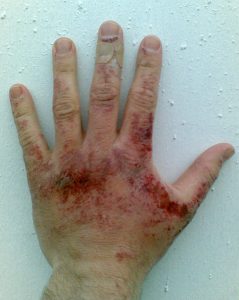Burn injuries come in three “degrees,” or levels of severity. These three different degrees of burns have different appearances, symptoms, and methods of treatment. To ensure that you can take proper action if you or someone around you gets burned, you should learn to differentiate between first, second, and third-degree burns.
First-degree Burns
In a first-degree burn, only the outermost layer of the skin, known as the epidermis, is damaged by heat. This causes the affected area redden, swell, and become painful. On the scale of severity, first-degree burns are at the bottom, meaning that they are very mild burns and should not be considered major injuries unless they cover large, sensitive areas of the skin.
Second-degree Burns
When both the skin’s outer layer (epidermis) and the layer just underneath it (dermis) are burned, the injury is now considered a second-degree burn. These burns are the most painful, and can be identified by severe swelling, blistered skin, and a red, splotchy color. Judging the potential danger of a second-degree burn is also tricky: if the burn affects an area less than 3 inches in diameter, it is considered a minor injury. If the affected area is larger, it should be treated as a major injury.
Third-degree Burns
 A third degree burn is the most severe type of burn injury, and, counter-intuitively, also the least painful. This is not due to a strange twist of fate; rather, third-degree burns penetrate deep enough to actually destroy nerve endings and stop pain signals from ever reaching the brain. In fact, besides damaging all layers of skin, a third-degree burn may destroy tissue as deep as, and including, the bone. Identifying a third-degree burn is not hard, as its symptoms are distinct from the other two: dry, charred skin which may turn either white or black in color, as well as the characteristic lack of pain. Victims of third-degree burns are in serious danger, as these injuries can easily cause shock and death.
A third degree burn is the most severe type of burn injury, and, counter-intuitively, also the least painful. This is not due to a strange twist of fate; rather, third-degree burns penetrate deep enough to actually destroy nerve endings and stop pain signals from ever reaching the brain. In fact, besides damaging all layers of skin, a third-degree burn may destroy tissue as deep as, and including, the bone. Identifying a third-degree burn is not hard, as its symptoms are distinct from the other two: dry, charred skin which may turn either white or black in color, as well as the characteristic lack of pain. Victims of third-degree burns are in serious danger, as these injuries can easily cause shock and death.
Location Matters
With all burns, the location of the injury is important. If a burn is located on a sensitive area of the skin, it should be treated as a major injury. Such areas include: the face, hands, feet, groin, or buttocks.
Protecting Yourself Against Burn Injuries
Fire has served as humanity’s double-edged sword for centuries. Stolen from the Gods, as illuminated by Greek mythology, it has given humans life, power and longevity. It has enhanced technology and protected us from the dangers of our environment. Unfortunately, though, it has taken away life as well. An untamed flame wrecks havoc on its environment, consuming everything with no regard for or discrimination against any person or thing. Its association with the ultimate demise, an eternity in hell or the underworld, heightens the fear and relinquishes control over its life-giving powers, underscoring its destructive capabilities.
The threat of fire is real. Negligence can lead to the ultimate price: the loss of a loved one. Every year, forest fires, appliance-malfunction fires, and other fires resulting from negligence pose a threat to the livelihood, safety and security of American families. According to the Centers for Disease Control and prevention (CDC), one person dies from a burn injury every two hours and another person is injured every thirty minutes.
It is important to understand the potential dangers in your house and to know what you can do to protect yourself and your family. Only 60% of American household have an escape plan in the event of fire, and of those, only 25% have practiced that plan. Even with these precautions in place, the cause of the fire may not be the homeowner’s fault. In these cases, it is important to know your rights.